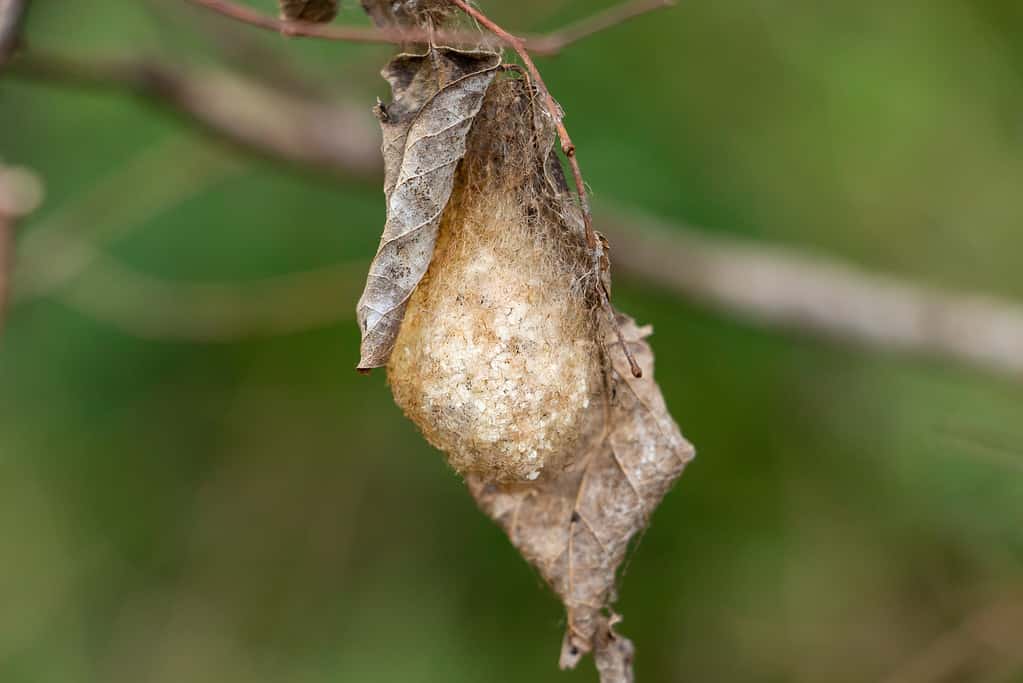The transformation of a caterpillar into a butterfly is a complicated process, involving the entire liquidation of the existing caterpillar. Later, it reassembles into a new form. The caterpillar morphs into a construct, webs to a safe spot, and surrounds itself with it for the transformation. This construct is a chrysalis.
What Does the Caterpillar Chrysalis Do?

Chrysalises are protective exoskeletons that shield a caterpillar as it morphs into a butterfly.
©iStock.com/JasonOndreicka
The chrysalis serves mostly as a protective shield for the caterpillar as it changes into a liquid state. During this period, the caterpillar is very vulnerable. The chrysalis holds it in while protecting it from the outside environment.
This is the “pupa” stage of the butterfly or moth’s life cycle. The caterpillar essentially dies within the chrysalis before reforming into a butterfly. Layers of silk (often hanging from a tree or a small branch) or attached directly to a tree suspends the chrysalis.
As the caterpillar digests itself, dissolving from a solid body into a liquid, the chrysalis holds everything in. Over time, new organs form and, eventually, wings. As the butterfly reaches completion, in its new state, the chrysalis softens since the transformation process requires so much to reach completion.
The chrysalis remains in place until the butterfly breaks free, usually around two weeks, though it can be much longer during the winter months.
Chrysalis or Cocoon

Cocoons are shielding made of silk and plant matter protecting caterpillars as they morph into moths.
©Sunshower Shots/Shutterstock.com
People tend to confuse cocoons and chrysalises often. Butterflies form a chrysalis while moths form a cocoon. The primary difference is the process. A caterpillar that turns into a butterfly essentially turns into its chrysalis, which is nothing more than a hardened exoskeleton for the duration of the process.
As the caterpillar transforms into its chrysalis, it often secures it to its tree or plant by putting together a series of silk webbings. A moth, on the other hand, constructs a cocoon with layers upon layers of silk.
The cocoon is mostly silk and designed to keep the moth warm and cozy throughout its transformation.
Time It Takes for a Chrysalis to Form

Taking about a week, a caterpillar will shed its skin to form the chrysalis. It will remain inside that for about two weeks.
©Barbara Ash/Shutterstock.com
It takes a caterpillar roughly seven days to shed its outer skin, forming the chrysalis it will remain inside of for the next two weeks. That makes the entire process, notwithstanding any outside circumstances (such as cold weather), roughly three weeks.
It can take up to ten days to form the chrysalis and it can also take an extra three days for the butterfly to emerge from the chrysalis. Those are acceptable timelines under normal conditions. If winter arrives in full force, before the chrysalis has completed its duty, the butterfly could remain within for months, in a state of something like hibernation.
As the end of the chrysalis draws near, it becomes softer, losing roughly half its weight and changing color. The latter is mostly because the butterfly within is defecting and the chrysalis contains that defecation. Since the chrysalis is translucent, it changes colors according to what’s inside.
What Makes the Caterpillar Form a Chrysalis?

It’s hormones that drive the process of a caterpillar forming a chrysalis.
©tcareob72/Shutterstock.com
The urge to form a chrysalis and morph into a butterfly is hormone-driven. This hormone is known as ecdysone and it’s the driving force behind the caterpillar’s sudden need to form a chrysalis. There is also a supporting hormone that helps drive the desire to form a chrysalis, known as the “juvenile” hormone.
It doesn’t help because it’s there; it helps because it suddenly becomes absent. In the sudden absence of the juvenile hormone, ecdysone increases and the caterpillar instinctively knows it’s time to start shedding and converting its outer skin into a chrysalis.
Pronunciation of Chrysalis
Chrysalis is pronounced kri – se – less.











